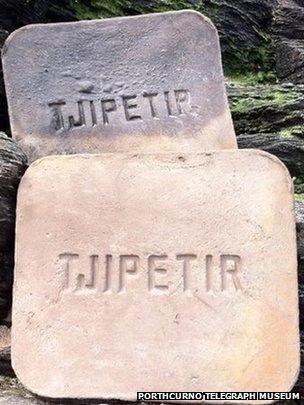Shipwrecked gutta percha blocks wash up in South West
- Published

TJIPETIR is believed to be the name of a 19th Century rubber plantation
About 40 large blocks of a rubber-like substance, believed to be from a shipwreck in the Atlantic Ocean, have washed up on European coasts.
The pieces of gutta percha have been found on beaches in Cornwall, Devon, northern France and the Netherlands in the last year.
The Porthcurno Telegraph Museum in Cornwall said the blocks bore the name of a 19th Century plantation.
The material was used to insulate telegraph cables on the seabed.
Marc Cragg from the museum said: "Gutta percha is from Indonesia and is very similar to rubber.
"It has been a central part of telegraph systems for the last 100 years or so."
His colleague Rachel Webster said: "Many of the cables which were insulated with it remain in situ on the seabed."
Teddy bear noses
Mr Cragg said: "It looks like there was a shipwreck 80 miles (130km) or so off the coast of Brittany in the Western Approaches."
He added that the gutta percha, which would have been stored as cargo, could have been released during a salvage operation.
"If you look at the distribution, it would make sense," Mr Cragg said.
The museum said the blocks, which were about 12in (30cm) by 14in (35cm) had the letters "TJIPETIR", which was believed to be the name of a rubber plantation in the Dutch East Indies in the 19th Century.
In recent months staff have been working to find out how many blocks have washed-up.
It added that gutta percha was used to make golf balls, teddy bear noses and decorative items such as picture frames and jewellery.
- Published28 November 2012